
For some years now, ever since I heard the first rumours in fact, I have been wanting to get in touch with the enigmatic Thomas Willenberg, from Sachsen, Germany.
In the late 90s and around 2000 he repeated much of the hardest stuff around, including an early ascent of Dreamtime, and the, at the time hardest problems in the Hollow Mountain Cave, Grampians, Australia. He also put up his own 8C, Transcendance, and repeated many of the hardest routes in Frankenjura.
I tried a few times to find ways to contact him, but without success, and then I sort of forgot about it when no more news about him came in...
Then a couple of years ago, I discovered 1) that he was still active and 2) that he had repeated some Fontainebleau problems that was considered unrepeated by most at the time, Trip-hop, 8C, and Dune, 8B+.
When he then made the FA of Shiva, 8C, I figured it was time to try and contact him again. This time, I managed to get ahold of his phone number by asking German maker of films and Monkee clothing, Hannes Huch.
Thomas agreed to an interview, and here it is.
Who is Thomas Willenberg? How did your "climbing career" begin?
I was born 30 April 1974 in the heart of the Sächsischen Schweiz, Germany.
In 1979 my father took me climbing for the first time. We scaled a tower, Den Einsammen Stein (The lonely rock) via a chimney.
Although I was scared, it would seem climbing made a lasting impression and fascinated me, because in the following years I climbed quite a lot, and this fascination is still there to this day.
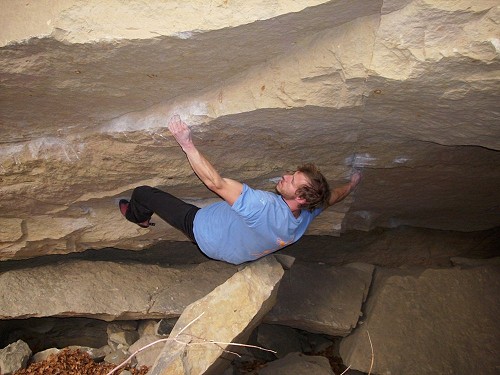
The name of the game has changed back and forth over the years. Sometimes more bouldering, but always routes, especially here in the Elbsandstein, with its bizarre towers and the adventurous climbing they provide.
You spent quite a lot of time climbing around the world and especially India in the late 90-ties. How come?
Integrating climbing and bouldering with trips all over the world has worked wonderfully, for example to India, Africa, Australia, the US and the UK.
Getting to know the countries through the famous and well-trodden tourist paths was complemented by the experiences given by the practice of the sport and everything that comes with it, like meeting people and coming to places you would otherwise never visit.
In India for example, especially in Mahabalipuram on the east coast, no climbers had been there before us.
The locals came and marveled at us, wondering what we were up to. They cheered and applauded happily when we succeeded on something. Their genuine enthusiasm, really moved us, even though to them it was an unimaginable luxury, to be able to travel to a country just to climb around on rocks of different sizes... Climbing is less than a subculture here.
During our trip Australia I got to know the Austrians Mungo, Klem [Loskot] and Floh. Very amazing people. Later we spent some time with them in the Elbsandsteingebirge.
In England, Stanage to be precise, I got to know, Ron Fawcett. We had some great days with him, and my admiration for his ability to still enjoy difficult climbing is unbroken.
As far as I know, for a long time, you have mostly been bouldering. What about it is it that attracts you so much? Any favourite style?
What draws me to bouldering is the simplicity. Not a lot of equipment, but basically just you and the rock. Perhaps this style is at the same time the most uncompromising. To find pleasure in the beauty of the formations and the joy of movement, and connecting to the environment.
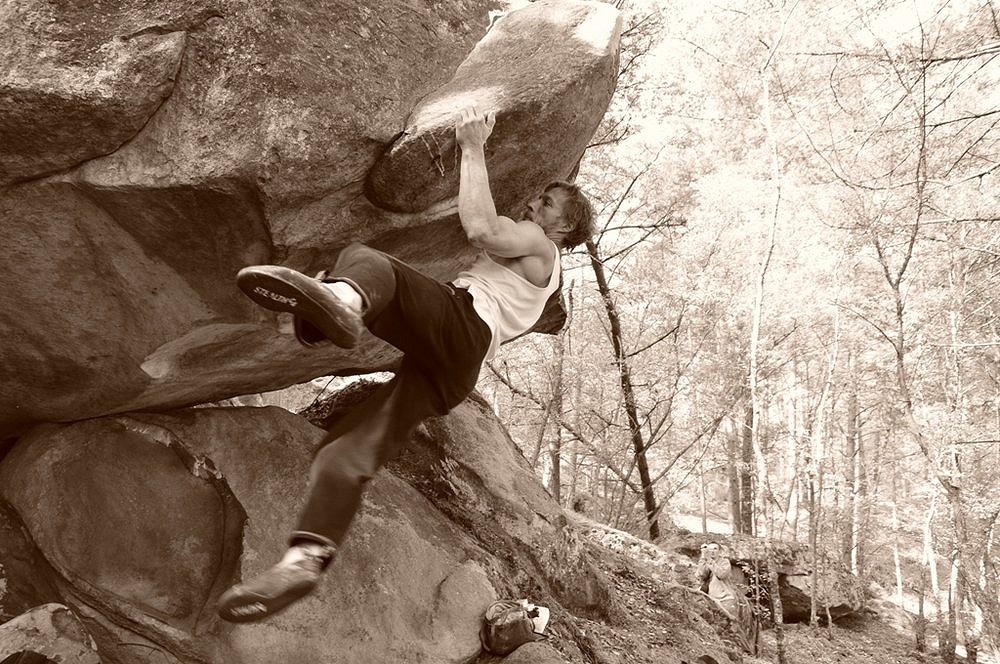
This idea also works well with dynamic climbing.
In Asia, I've often admired the monkeys, which really have a way of degrading us as climbers to real amateurs when it comes to movement. Blank sections of the rock are simply passed with a jump where the body is catapulted upwards and then reconnected to the rock.
A way of setting the spirit free so to speak... a great game!
I have often searched for problems where this kind of dynamic style is necessary, and sometimes I still do. To me the movement in climbing/bouldering is a game, where the end goal is confronting and sometimes defeating myself and my own weaknesses. To do something which goes beyond the limitations of the mind. Only your own psyche and physique are limiting factors.
Do you have any kind of goals with your climbing?
When it comes to the level of difficulty, I have always focused on existing problems. Back then it was things like Fred Nicole's Leopard cave in Rocklands or Phillip Le Denmat's Duell in Fontainebleau.
Feedback from repeaters of my own creations has always made me happy. To hear how someone else has experienced the problem. Like when Fred [Nicole] called me and we discussed my problem The Vice, which he had made the 2nd ascent of.
But by now, due to the emerging on-line climbing media and the transparency that followed, the climbing of hard boulder problems has become part of the media game, losing some of its soul in the process.
Also I fell for this phenomenon of consumerism for a while. But this was never and will never be my way.
Nowadays, a rock has to really inspire me, for me to be able to commit fully and give it my all. Before I was more of an omnivore in that sense.
This is perhaps also the reason why I can be so highly motivated for some boulder problems or routes, and that I, so far, have remained injury free.
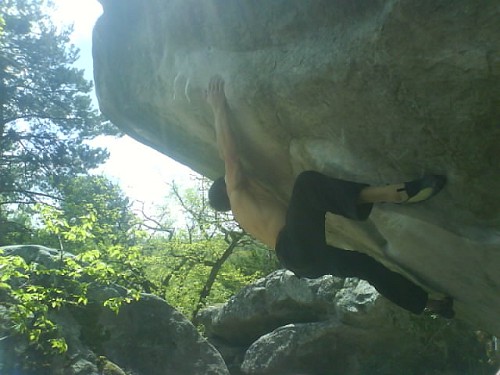
Even when you repeat or make first ascents of 8C's, it doesn't make the headlines of climbing media. What do you think of this? Do you think you get the respect you deserve?
At the end of the 90s, making the climbing magazines was important to me. There were some small articles and portraits.
But does this make you happy?
Maybe if you are either very vain, or want or need to make a living from it [climbing].
Fortunately, I'm not at all vain, but sometimes astonished by my power.
But I make my money from my work as an Art Therapist and for the necessary clearness of mind, I take care of trees. To me that's a way to keep both feet on the ground so to speak.
Can you tell me about Shiva and your repeats of Trip-hop and The island?
About this or that 8C... there are so many difficult problems. Behind them all, there's will, talent, self sacrifice, inspiration or psyche if you like, and engagement. However, the most important friends, is that it is all these parts that make the whole. This is the sum or worth of the whole thing.
The number is a result of these factors... a numerical phenomenon.
Climbs that fit me well, like The Island in Fontainebleau, I could dispatch very quickly. It is as if it was made for my body.
There are also tons of problems which I admire in wonder of how someone is able to do them.
The line of what was to become Shiva in Fontainebleau, fascinated me, especially as it initially seemed impossible to find a solution.
I discovered the line when I was trying the nearby Khéops, only a few meters to the left.
I told myself that "If you can do Khéops, then you can try this line for the rest of the vacation.
Even Khéops sd was no problem to get done on this vacation, but Shiva was a different story. It required something more.
The key move, making a dynamic move with the left hand, having a hook for the right foot and the left hand on a micro hold required many tries and a lot of patience before I could make the ascent.
This problem is dedicated to my now deceased Bullterrier Shiva, who waited patiently by the boulder, many times for hours, and who surely asked herself many times what on earth I was doing.
After Shiva have I also asked myself, how and why I can put so much pressure on myself that I want to hold on to such lousy holds...
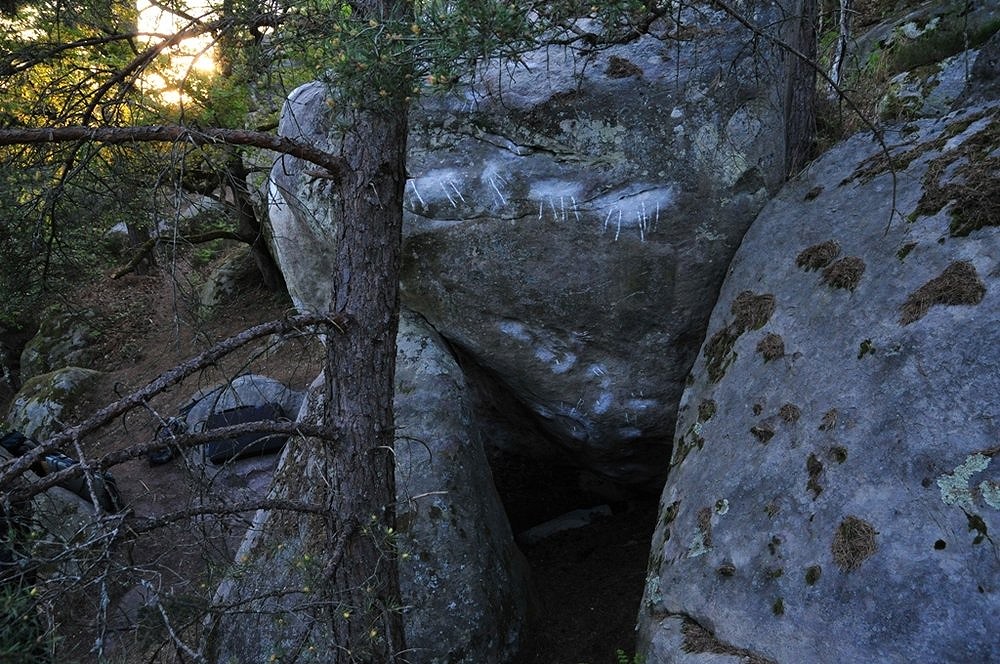
You have been in the top for very long. Do you have any thoughts on how bouldering has changed during these years?
In the last decade both climbing and bouldering have changed significantly.
At the end of the 90s and the start of the 2000, the scene was dominated by charismatic personalities. These have been replaced by less colourful people in a never ceasing performance spiral.
But maybe I'm just old fashioned, and probably this is simply something that belongs to this modern era and its character.
Also I have, because of various personal circumstances, such as more work, had less time to focus on bigger or smaller rocks, but even if the process has changed, it doesn't mean it has become less productive.
Back in 2000 you made the FA of Brad Pitt sds and since then it has only seen one repeat. I saw some photos back then and it looked like you used the original jump beta. Why?
At the time, during our stay in England, I absolutely wanted to climb Brad Pitt in the original way. If only because Ben [Moon] and Jerry [Moffat] had run a bet about whether Jason Myers' problem was doable or not.
After three hours or so, I could repeat the problem in the original way, and well... as there was a possible sit start...
Two underclings, a set up move and a dyno...
I think Ron Fawcett was pleased at the time. An unknown German, and a sit start as the, at the time, most difficult boulder problem in the Peak...
"You must be very strong, man.", was Ben's comment.
But the development never stops, some time my variation of this problem will be repeated, or maybe it already has been, when the conditions are right and some dynamic guy with the right body type comes along.
That time, I was also lucky enough to be given information about some open boulder project. It was a great vacation in many ways.
When the climbing magazine On The Edge asked me for photos I was happy, and a whole series of photos from Brad Pitt were published.

Sometime we all want a piece of the glory...
But at the end of the day I can say that what's the most valuable to me is a good talk with a friend, a healthy amount of self-criticism and, of course, self-irony.
Despite all that we do to ourselves and how much time and thought we dedicate to become better at climbing or bouldering, it's still not that important.
But it is a wonderful waste of time!

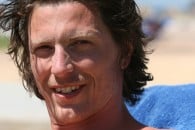



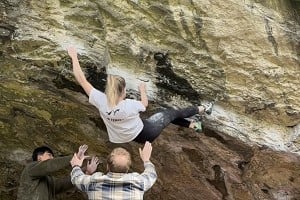
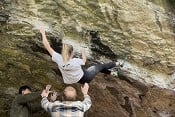

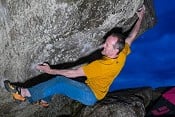

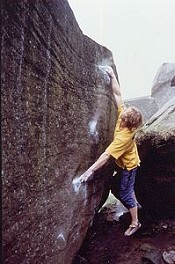
Comments